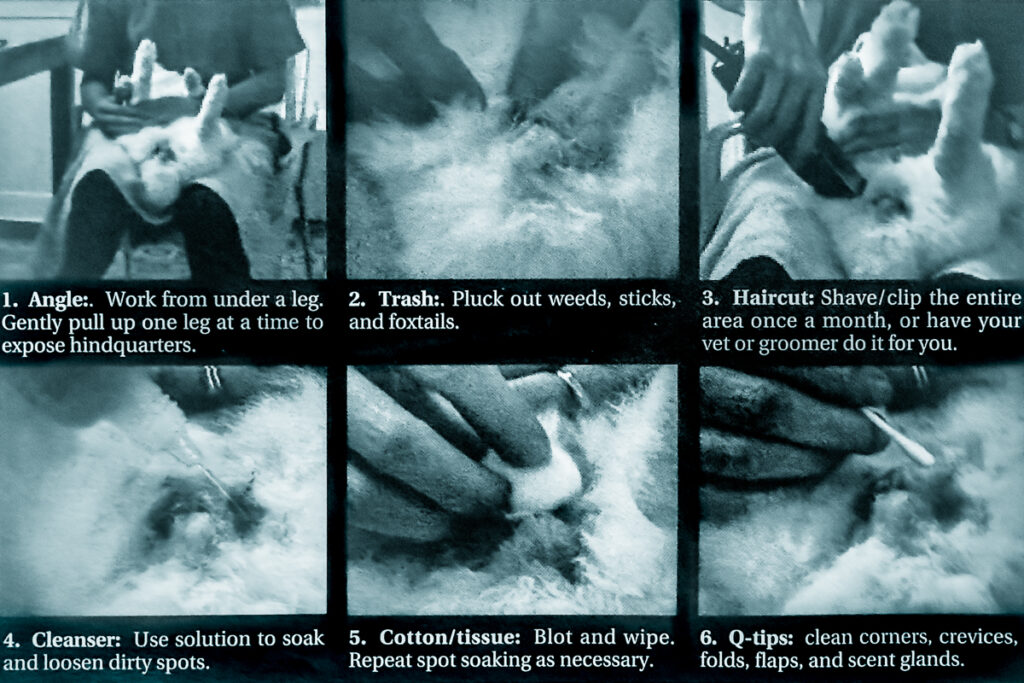As disgusting as the subject is, we cannot ignore this eminent warm-weather danger. Flies can strike a healthy animal who has temporary loose stools, but at particular risk are your aging, disabled, or overweight rabbits who are not able to clean themselves. Within a 24-hour period an otherwise stable rabbit can enter a terminal state of shock due to maggot infestation. Every fatality reported to us last year bore with it considerable human grief and guilt. We blame ourselves for lack of vigilance. And besides guilt, we feel anger-that something as worthy and dear to us as our rabbits can be taken down by something as loathsome as a fly.
Often the stricken rabbits are being exceptionally well cared for. They may have pasty stools or urinary problems that require frequent bathing-a problem in itself.
Attractive Conditions
Moisture, warmth, and odor attract flies. If open sores are present, or if thick fur is dampened with urine or feces, flies will head toward these warm incubation areas to lay their eggs. The chances are greater if the rabbit is outside, but it only takes one fly indoors to do the damage.What kind of damage? Maggots do not stop at the surface. Once they have consumed external debris, they go right on to sound flesh (sometimes up the back where you don’t see it), and once in the flesh, they produce toxins that create a state of shock.
Warning Signs
Seizures: Some rabbits have “itchy skins” seizures. But instead of being toxin related, these are caused by local nerve sensors on the surface of the body triggering a general or overall nerve reaction, resulting in a seizure. Rabbits are sensitive to surface irritations.
Our rabbit Phoebe gave us this early warning years ago, in time to save her life. When our rabbit Velma had a seizure last year, I turned her over and found that “foxtails” had worked their way into the folds around her scent glands. Not all rabbits respond this way to an “attack” on the hindquarters, but if your rabbit does have a seizure,check for surface irritations.
Listlessness: This is never a good sign in a rabbit. It usually means something is seriously wrong. In the case of fly strike, the rabbit may already be in shock.
Your course of action will depend on how advanced the infestation is and how far you are from your vet. If the larvae are small and still few in number, you can hurry to the veterinary hospital. If the larvae are large and numerous, you have little time. Rinsing them off is very difficult, but I have removed them by completely submerging the trunk in a tub of water. It takes two people to do this effectively; one to hold the upper half of bunny above water; the other to wash out all infested areas. It requires about three tub refills, followed by careful drying. Wet fur provides an environment for more eggs to hatch. Avoid dampening any more area than necessary.
My veterinarians prefer a completely dry technique for maggot removal and pluck them by hand or tweezers. Most of their clients are too squeamish to do this.
Chemicals strong enough to destroy the maggots are often too toxic to apply to a bunny in shock. If you are successful at removing the maggots yourself, you will still need to get your bunny checked by a veterinarian, as treatment may be necessary for shock or toxins.
Prevention
Ridding the environment of flies, by means of chemical insecticides may damage the environment, animals, and people along with the flies. Fly traps catch many flies but not all. Repellents may work temporarily, but one must remember to use them repeatedly. Screens on doors and windows reduce the number of flies that get into the house, but some slip through.
At best we can only reduce, but we can’t eliminate flies from the environment. So we turn a watchful eye to the potential victim.
To make the environment on the rabbit as hostile as possible to egg-laying flies, here are two rules:
- Keep it dry! Don’t dip the rabbit’s rear end into water. (You resort to that only after an infestation but not for prevention.) Instead, use a “spot cleanser” for softening, loosening and removing feces stuck to the hindquarters.
- Keep it short–even shaved. Clear any area that tends to stay damp. This will also enable you to get to these areas with your cleaning solutions.
External cleansers: Nolvasan Otic solution, available through your veterinarian or veterinarian supply catalog, is used for loosening ear wax but also works well on the hindquarters. Its antibacterial/ anti-fungal agents soften caked-on feces and/or yeast.
A good cleaner from your pet supply store is Nolvadent, which you might already be using to brush your dog’s teeth.
If your bunny’s problem is urine-soaked fur rather than fecal material, then ChlorhexiDerm Flush (also non-prescription) may be your best choice, since it has a drying agent.
I apply the appropriate cleanser, to my eleven special-care rabbits, on alternating days, before they go outside to their playpens.
©Copyright Marinell Harriman, Bob Harriman. All Rights Reserved. Republished with the permission of the author.
Fly Strike was originally published in House Rabbit Journal Volume II, Number 12.
-

Marinell Harriman
Marinell Harriman is the author of The House Rabbit Handbook. Over the past four decades she has fostered and rescued hundreds of rabbits. She has published numerous articles on house rabbit philosophy, care, and behavior. She has a special place in her heart for disabled and special needs rabbits.
View all posts -

Bob Harriman
Bob has lived with house rabbits for over 40 years. He is the designer and illustrator of all five editions of The House Rabbit Handbook.
View all posts
